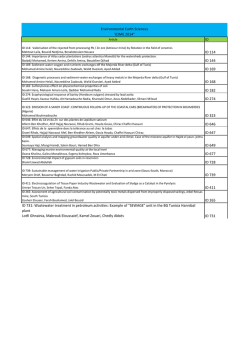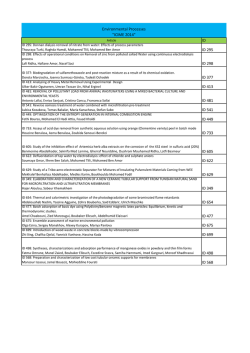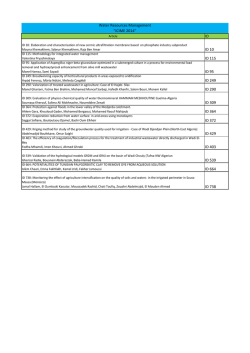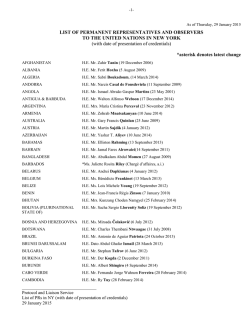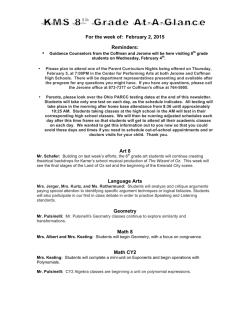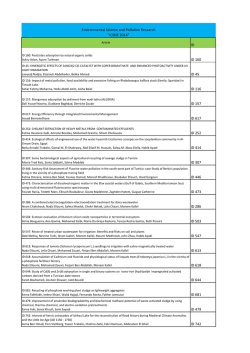
here… - Affinity Intercultural Foundation
The Hon Justice M J Beazley AO Affinity Intercultural Foundation, Sydney 27 August 2014 The intersection of the Australian law and the Islamic faith: A selection of cases Affinity Intercultural Foundation 27 August 2014 The Hon Justice M J Beazley AO1♦♦ Introduction The separation of Church and State is as fundamental to the Australian legal system as is the rule of law itself. That said, religion often underlies the way in which various sections of our community function, both within that particular grouping and more broadly. Whilst religion is undoubtedly intended to pave the way to Heaven for us mortal beings, it is often central to a person’s morals, behaviours and sense of identity on this earth. Importantly for the law, religion may order the ways in which a person organises his or her worldly affairs. Religious and cultural diversity is a great strength of Australian society. However, the religious and cultural practices, particularly (but not only) those that do not share a Christian-Judeo foundation, may sometimes be an uncomfortable fit. The tension is not necessarily between a religious or cultural grouping and Australian law. Tensions can arise within communities. There is perhaps be no better example of this than the long-running battle in the New South Wales Supreme Court between the Macedonian Orthodox Community Church St Petka and the Archbishop. 1 President of the New South Wales Court of Appeal. I express my thanks to the Court of Appeal Researcher, Jessica Natoli, and my Tipstaff, Kathleen Heath, for their extensive research and valuable assistance in the preparation of this paper. ♦ 1 The Hon Justice M J Beazley AO Affinity Intercultural Foundation, Sydney 27 August 2014 Although the dispute spanned many technical questions in the field of equity and trusts, the underlying ‘human’ dispute arose out of the appointment of a parish priest, by the Bishop in 1996. The relationship between the congregation and the priest deteriorated. The Executive Council of the parish excluded the Bishop and the priest from the Church and appointed two new priests. The Bishop and the priest commenced legal proceedings in 1997. The intractability of the dispute can be illustrated by reference to the procedural history. There were 10 iterations of the statement of claim, that is, the pleading upon which the claim was based. More than 21 first instance decisions of a substantive and interlocutory nature in this matter have been delivered by the Court. There were four applications for judicial advice; a special procedure under the Trustee Act whereby five decisions by the Court of Appeal; and one High Court judgment. Subject to a question of costs, the proceedings were brought to a conclusion in February 2014, when the High Court refused special leave to again appeal, seventeen years after the legal battle began. As the Macedonian Church case illustrates, whatever the underlying religious controversy may be, disputes between parties must be resolved according to the law. That is a fundamental tenet of the rule of law. That is not to say that judges are not willing to engage and grapple with belief systems or cultural practices with which they may not previously have been familiar, when those belief systems or practices assume importance as facts relevant to the determination of a particular case. Some of the cases that I discuss in this lecture illustrate how Australia accommodates religious and cultural practices. Other cases will illustrate how that is not always possible. I will also refer to a third category of case where no question of religious or social practice was involved and where there were unsatisfactory outcomes to the persons involved. The point I do wish to make is that individuals who arrange their affairs in accordance with religious or cultural practices cannot afford to ignore Australian civil 2 The Hon Justice M J Beazley AO Affinity Intercultural Foundation, Sydney 27 August 2014 law. It is up to the individual to take responsibility for ensuring that the formal requirements of the law are met in order to protect that person’s interests. Wills and freedom of testation In 2012, the ACT Supreme Court held that the will of an elderly Muslim woman named Mariem Omari was invalid. Under the will, which was drafted in accordance with a precedent for members of the Islamic faith, each of Mrs Omari’s sons was to receive twice as much money as each of her daughters.2 The case received media attention, much of which incorrectly assumed that the will was challenged on the basis that Sharia law should not apply to the distribution of Mrs Omari’s estate.3 In fact, the daughter’s argument was that her mother was suffering from advanced dementia at the time of the will’s execution, and lacked testamentary capacity.4 The Court applied the test laid down in Banks v Goodfellow, to assess the ability of Ms Omari to understand the will’s nature and effect, the extent of her property and the claims of persons recognised under Australian law to be eligible to share in her estate.5 Having found that at the relevant time Mrs Omari was incapable of understanding these things, the Court was required to hold the will invalid. The nature of the testamentary dispositions and the fact that the will was drafted in accordance with religious principles did not form part of the Court’s reasoning. As academic Jan Ali has noted, the media coverage of the Omari case evinced a fundamental misunderstanding of the treatment of religion within Australia’s secular legal system.6 Australia is a multi-cultural, multi-faith society and a significant proportion of the population organises their affairs in accordance with cultural practices or principles derived from their religion. When such principles assume 2 Mohamed Omari and Mustapha Omari v Fatma Omari [2012] ACTSC 33, 7-8. Sophie Gosper, ‘Respect our way on wills, say Muslims’, The Australian (online) 15 March 2012; Patricia Karvelas, ‘Roxon baulks at role for sharia’, The Australian (online) 17 March 2012; Caroline Overington, ‘Daughter disputes Muslim will that gave brothers twice as much’, The Australian (online) 14 March 2012. 4 Mohamed Omari and Mustapha Omari v Fatma Omari [2012] ACTSC 33, 2, 9. 5 Mohamed Omari and Mustapha Omari v Fatma Omari [2012] ACTSC 33, 64-65. 6 Jan Ali, Religion and the law: Sharia-compliant wills in Australia, (28 June 2012), The Conversation <http://theconversation.com/religion-and-the-law-sharia-compliant-wills-in-australia-6795>. 3 3 The Hon Justice M J Beazley AO Affinity Intercultural Foundation, Sydney 27 August 2014 relevance in matters that come before the courts, courts will only interfere where there is some inconsistency with Australian legal principle. To put it another way, legal documents are not held invalid because they are drafted in accordance with the tenets of a religion, but because of legal impropriety.7 Had Mrs Omari executed her will before she lost capacity, she would have been free to dispose of her estate in whatever manner she wished, including in accordance with the tenets of Islam, provided that the will met the formal requirements for validity in her state or territory.8 Her freedom of testamentary disposition was subject to the entitlement of eligible persons, including her daughters, to make a claim for family provision under the Succession Act, if they were unhappy with the bequest to them.9 However, it is never certain whether such a claim would be successful. Among other things the Court would take into consideration Mrs Omari’s strong desire to dispose of her estate in accordance with the principles of her religion,10 and to assess whether the will in fact made adequate provision for her daughters.11 The vast majority of wills are not challenged and, provided that they meet the requirements for validity, estates will usually be distributed in accordance with the deceased person’s wishes. The New South Wales Supreme Court recently had occasion to examine the question of whether the freedom of testation extended to allowing people to dispose of their estate in accordance with their religious convictions. In the case of Hickin v Carroll (No 2) [2014] NSWSC 1059, the late Mr Patrick Carroll had been “enraged” by his ex-wife and children’s conversion to the Jehovah’s Witness faith after his marriage broke up. In his will, he made his gifts to his ex-wife and children conditional upon them converting to Catholicism within three months of his death. None of them did so. They brought proceedings in the Supreme Court to challenge the validity of the condition that they convert to the Catholic faith, arguing that the condition discriminated against them on the grounds of their religion, and promoted 7 Jan Ali, Religion and the law: Sharia-compliant wills in Australia, (28 June 2012), The Conversation <http://theconversation.com/religion-and-the-law-sharia-compliant-wills-in-australia-6795>. 8 In NSW see Succession Act 2006 (NSW) s 6. 9 Succession Act 2006 (NSW) s 57(c). 10 Succession Act 2006 (NSW) s 60(2)(j). 11 Succession Act 2006 (NSW) s 59(1)(c). 4 The Hon Justice M J Beazley AO Affinity Intercultural Foundation, Sydney 27 August 2014 discord within the family in a way that affronted modern twenty-first century societal norms and concepts of universal human rights and freedoms. The Court rejected those arguments, confirming that the testamentary conditions in restraint of religion was not void on public policy grounds. Islamic family law: marriage and divorce Mohamed v Mohamed and Another [2012] NSWSC 852 In a recent Supreme Court matter, Mohamed v Mohamed, a couple who were married under Islamic law had entered into a prenuptial agreement stating that the wife was entitled to a $50,000 dowry in the event that her husband divorced her.12 Under the terms of the agreement, if the wife ended the relationship or there was a mutually agreed separation, the wife would not receive the dowry.13 It was clear that both parties had received independent legal advice as to the effect of the agreement and had entered into it willingly.14 However, when the couple’s marriage broke down they could not agree as to which of them had initiated the divorce and the husband refused to pay.15 The wife commenced proceedings in the Local Court seeking to enforce the agreement, and the Local Court found as a matter of fact that the husband had ended the relationship.16 He was ordered to pay the $50,000. The husband appealed, arguing that the agreement was unenforceable for public policy reasons. He asserted that the contract was effectively an ‘agreement of servitude,’ in that its purpose was to force him to stay in the marriage against his will.17 The Court did not accept this argument. As a general rule, courts will enforce the principle of ‘freedom of contract’, and will be reluctant to interfere with agreements voluntarily entered into by parties of full legal 12 Mohamed v Mohamed [2012] 47 Fam LR 683, 685. Mohamed v Mohamed [2012] 47 Fam LR 683, 688. 14 Mohamed v Mohamed [2012] 47 Fam LR 683, 688. 15 Mohamed v Mohamed [2012] 47 Fam LR 683, 686. 16 Mohamed v Mohamed [2012] 47 Fam LR 683, 686. 17 Mohamed v Mohamed [2012] 47 Fam LR 683, 688-689. 13 5 The Hon Justice M J Beazley AO Affinity Intercultural Foundation, Sydney 27 August 2014 capacity.18 There are a number of exceptions to this rule, including where enforcing a contract would be contrary to public policy. However, this does not mean that courts have a discretion to declare agreements unenforceable that in the opinion of an individual, or indeed in the opinion of the individual judges, are against the public interest. Rather, as Isaacs J has noted: “The public policy which a court is entitled to apply as a test of validity to a contract, is in relation to some definite and governing principle which the community as a whole has already adopted.” 19 Harrison AsJ found that there was no accepted principle within the community that an agreement for the payment of a dowry was against public policy.20 Her Honour, referring to an academic article by Black and Sadiq, stated: “… (a dowry) is a required component of a valid Islamic contract of marriage … It is a payment designed to provide for a wife when she is no longer required under Sharia law to be financially maintained by her husband, and as such has been an important security net in Muslim societies.” 21 Although there was no Australian authority on the subject, cases from the United States, the United Kingdom and Canada, were overwhelmingly in favour of enforcing contracts for the payment of dowries.22 Relevantly, in the process of upholding such an agreement, the British Columbia Supreme Court has stated: “Our law continues to evolve in a manner which acknowledges cultural diversity. Attempts are made to be respectful of traditions which define various groups who live in a multi-cultural community. Nothing in the evidence before me satisfies me that it would be unfair to uphold the provisions of an agreement entered into by these parties in contemplation of their marriage.” 23 18 Cattanach v Melchior (2003) 215 CLR 1, in Mohamed v Mohamed [2012] 47 Fam LR 683, 689. Wilkinson v Osborne (1915) 21 CLR 89, 96-97, in Mohamed v Mohamed [2012] 47 Fam LR 683, 689. 20 Mohamed v Mohamed [2012] 47 Fam LR 683, 693. 21 Mohamed v Mohamed [2012] 47 Fam LR 683, 690. 22 Mohamed v Mohamed [2012] 47 Fam LR 683, 690-693 23 in Mohamed v Mohamed [2012] 47 Fam LR 683, 691. 19 6 The Hon Justice M J Beazley AO Affinity Intercultural Foundation, Sydney 27 August 2014 The Court’s decision that the agreement should be enforced was consistent with comments made by the High Court of Australia in the 1962 decision Haque v Haque. In that case, a second wife in a polygamous Islamic marriage sought to enforce a deed that she and her husband had executed immediately prior to their marriage ceremony.24 The deed provided that she and her children were entitled to share in her husband’s estate in accordance with Sharia law, despite any contrary testamentary dispositions.25 The deceased husband’s brother, who was the sole beneficiary under the will, argued that the deed was void for public policy reasons as the second marriage was not recognised under Australian law and the agreement therefore contemplated cohabitation outside of lawful marriage.26 Although the Court ultimately did not have to decide the point, the judges stated: “In the circumstances of this case it is by no means certain that a court would adopt such a position: for it was an attempt by Muslims honestly and genuinely to establish a relation which Muslim law would recognise …” 27 Ghena Krayem has observed that the circumstances in Mohamed v Mohamed were rare, in that it is not the usual course for Islamic couples to have a lawyer draw up a formal deed setting out their agreement as to the amount of the dowry and the circumstances in which it is to be paid. Several Imams interviewed for Krayem’s research expressed concern that because the dowry is not a right recognised by Australian law, Islamic women could be left in a vulnerable position if their husband refused to pay.28 In this sense, Mohamed v Mohamed is a powerful example of what Krayem describes as the ‘skilful navigation’ of dual systems.29 The couple married in a Sharia ceremony and did not ultimately obtain a marriage recognised by Australian law. However, the wife nevertheless utilised aspects of the Australian law to protect her interests, by having a formal contract drawn up and by enforcing that contract through the courts. 24 Haque v Haque and others (1962) 108 CLR 230, 231. Haque v Haque and others (1962) 108 CLR 230, 231. 26 Haque v Haque and others (1962) 108 CLR 230, 238. 27 Haque v Haque and others (1962) 108 CLR 230, 249. 28 Ghena Krayem, Islamic Family Law in Australia: to recognise or not to recognise, (Melbourne University press 2014), 145. 29 Ghena Krayem, Islamic Family Law in Australia: to recognise or not to recognise, (Melbourne University press 2014), xv. 25 7 The Hon Justice M J Beazley AO Affinity Intercultural Foundation, Sydney 27 August 2014 Kavanagh v Akhtar (1998) 45 NSWLR 588 The next case I will discuss also concerned an Islamic marriage, but the issues that arose were very different from those in Mohamed v Mohamed. In Kavanagh v Akhtar Mrs Akhtar sustained a shoulder injury after a heavy box fell on her while she was shopping. Due to chronic pain from her injury she was unable to care for her very long hair and felt she had no choice other than to cut it short.30 Her husband was a strict Muslim and was extremely upset that this had occurred, particularly without his permission, as he believed that he had a right under Sharia law to control his wife’s actions in general, and he also believed that there was a specific rule prohibiting women from cutting their hair without their husband’s consent.31 Further, it was customary for women in Mrs Akhtar’s cultural group not to cut their hair, and there was evidence that Mr Akhtar had found his wife’s long hair very beautiful.32 The marriage, which had previously been a happy one,33 was destroyed. Mrs Akhtar’s husband left her and she was diagnosed with a major depressive illness.34 The issue to be decided by the Court of Appeal was whether Mrs Akhtar was entitled to damages from the owner of the shop to compensate her for the psychiatric injuries flowing from the breakdown of her marriage, or whether she should only be compensated for the physical injuries sustained in the accident. The owner of the shop conceded that the shoulder injury caused Mrs Akhtar to cut her hair.35 The trial judge made unchallenged findings, based on the evidence of Mrs Akhtar, her daughter, an Imam and several psychologists, that the cutting of the hair materially contributed to the marital breakdown, which in turn caused Mrs Akhtar’s psychiatric injuries.36 This meant that, in legal terms, factual causation was established between the shop owner’s negligence and the psychiatric harm 30 Kavanagh v Akhtar 45 NSWLR 588, 594. Kavanagh v Akhtar 45 NSWLR 588, 594. 32 Kavanagh v Akhtar 45 NSWLR 588, 594. 33 Kavanagh v Akhtar 45 NSWLR 588, 595. 34 Kavanagh v Akhtar 45 NSWLR 588, 595. 35 Kavanagh v Akhtar 45 NSWLR 588, 594. 36 Kavanagh v Akhtar 45 NSWLR 588, 596. 31 8 The Hon Justice M J Beazley AO Affinity Intercultural Foundation, Sydney 27 August 2014 suffered by Mrs Akhtar. In other words, ‘but for’ the shoulder injury sustained in the accident, Mrs Akhtar would not have suffered the relevant psychiatric harm. The question then, was whether it was appropriate to find the shop owner legally responsible for the harm suffered by Mrs Akhtar as a result of her husband’s reaction to the cutting of her hair. In the law of negligence there is a principle that a negligent party takes their victim as they find them.37 This means that the law places the responsibility on individuals who engage in risky behaviour to bear in mind that some people may have beliefs or vulnerabilities that make them more susceptible to harm than others, rather than imposing legal responsibility on the injured party for possessing that belief or vulnerability .38 As McHugh J has observed: “… the defendant must take the plaintiff with all his weaknesses, beliefs and reactions as well 39 as his capacities and attributes, physical, social and economic.” This principle is not absolute, however the Court in Kavanagh v Akhtar found that it could be applied to the facts of the case, stating: “I see no reason why the appellant should not take the respondent in the family and cultural setting that she lived…Equality before the law puts a heavy onus on the person who would argue that the ‘unusual’ reaction of an injured plaintiff should be disregarded because a minority religious or cultural situation may not have been foreseeable.” 40 What was important was that the general type of injury suffered by Mrs Akhtar was foreseeable, even if the precise chain of events leading to it was not.41 The Court determined that it was a foreseeable result of Mrs Akhtar’s shoulder injury that she would struggle to attend to matters of ‘personal hygiene and adornment’, and it was 37 Kavanagh v Akhtar 45 NSWLR 588, 601. Guido Calabresi, Ideals, Beliefs, Attitudes and the Law (Syracuse University Press 1985) 47. 39 Quoted in Kavanagh v Akhtar 45 NSWLR 588, 601. 40 Kavanagh v Akhtar 45 NSWLR 588, 601. 41 Commonwealth v McClean (1996) 41 NSWLR 389, cited in Kavanagh v Akhtar 45 NSWLR 588, 600. 38 9 The Hon Justice M J Beazley AO Affinity Intercultural Foundation, Sydney 27 August 2014 foreseeable that this could cause a marital breakdown.42 The Court also thought it was foreseeable that the breakdown of Mrs Akhtar’s marriage following her injury could result in psychiatric harm.43 That the precise sequence of events leading to the psychiatric injury, including the cutting of the hair and the husband’s reaction, may not have been foreseeable, was irrelevant. Mrs Akhtar’s damages were reassessed to compensate her for the distress, illness and suffering inherent in the psychiatric injury she had sustained. Islamic banking and finance In recent years a number of matters have come before the courts involving litigants who have fallen victim to financial disasters due to engaging in Islamic banking practices. This is ironic, a particularly given that Sharia financial law is founded on principles of social justice. For example, I understand that the prohibition on lending with interest has as its central concerns the protection of the vulnerable and the need to ensure that rewards and losses are distributed equitably.44 As Salim Farrar has explained: “(Under Sharia law) opportunist lending is viewed as unfair, whether the borrower is an entrepreneur seeking to start up a business – as only the lender is guaranteed a financial return – or a borrower with a particular need, because the lender could exploit the former’s vulnerability.” 45 While several institutions in Australia offer Sharia-compliant financial products, including Islamic mortgages, the cases I am about to discuss involve individuals who dealt with large sums of money without the assistance of any financial institution, Sharia-compliant or otherwise. These cases demonstrate the risks inherent in such a course of action. They also demonstrate that where individuals have not taken steps at the outset to protect their interests under Australian law, the courts may not be able to assist them. 42 Kavanagh v Akhtar 45 NSWLR 588, 602. Kavanagh v Akhtar 45 NSWLR 588, 602. 44 Abu Umar Faruq Ahmad Ph.D, Theory and Practice of Modern Islamic Finance: The Case Analysis from Australia (BrownWalker Press, 2010) 98. 45 Salim Farrar, ‘Accommodating Islamic Banking and Finance in Australia’ (2011) 34(1) UNSW Law Journal 413, 417. 43 10 The Hon Justice M J Beazley AO Affinity Intercultural Foundation, Sydney 27 August 2014 Khalid v Perpetual Ltd [2012] NSWCA 153 In Khalid v Perpetual Ltd46 the appellant, Mr Khalid, entered into an agreement to purchase a home from the second respondent, Mrs Dilati. Under the terms of the agreement Mr Khalid was to pay Mrs Dilati the purchase price of the home in instalments, as he could not afford to buy the property outright and did not wish to enter into a mortgage with a bank due to the prohibition on interest under Islamic law.47 The parties agreed that once the purchase price had been paid in full, Mrs Dilati would transfer the home to Mr Khalid, but until then Mrs Dilati would remain the registered owner.48 Under the Real Property Act (NSW) the register is the source of title,49 meaning that despite the existence of the contract of sale between Mrs Dilati and Mr Khalid, and despite Mr Khalid’s payment of large sums of money to Mrs Dilati, Mrs Dilati remained the legal owner of the home. In addition, Mr Khalid did not search the register to ascertain whether the land was already encumbered by a mortgage or other proprietary interest before he commenced to pay for the property. Several years later, Mr Khalid had paid the majority of the purchase price and he and his family were living in the home.50 At this point he discovered that the home was subject to a registered mortgage in favour of a financial institution, which secured Mrs Dilati’s debt of more than half a million dollars, and that Mrs Dilati had defaulted on repayment of the loan.51 (I pause here to note that in their written agreement Mr Khalid and Mrs Dilati had clearly provided that any disputes arising from the transaction were to be resolved in accordance with Islamic law and without recourse to the courts.52 46 There were Khalid v Perpetual Ltd (formerly known as Perpetual Trustees Australia Ltd) and Another [2012] NSWCA 153. 47 Khalid v Perpetual Ltd (formerly known as Perpetual Trustees Australia Ltd) and Another [2012] NSWCA 153, 6. 48 Perpetual Limited (formerly known as Perpetual Trustees Australia Limited) v Marwa Dilati and Khalid Ali Khalid [2011] NSWSC 1259, 10. 49 Real Property Act 1900 (NSW) s 42. 50 Khalid v Perpetual Ltd (formerly known as Perpetual Trustees Australia Ltd) and Another [2012] NSWCA 153, 11-14. 51 Khalid v Perpetual Ltd (formerly known as Perpetual Trustees Australia Ltd) and Another [2012] NSWCA 153, 20. 52 Perpetual Limited (formerly known as Perpetual Trustees Australia Limited) v Marwa Dilati and Khalid Ali Khalid [2011] NSWSC 1259, 10. 11 The Hon Justice M J Beazley AO Affinity Intercultural Foundation, Sydney 27 August 2014 several attempts to moderate the dispute with an Imam. However, the involvement of the third party mortgagee company, which was entitled to seek an order for possession in the Supreme Court in order to exercise its power of sale, meant that there could be no resolution between them. Practical difficulties in resolving the dispute according to Islamic law would have arisen in any event, as Mrs Dilati disappeared and could not be located by Mr Khalid after the extent of her indebtedness came to light.) Perpetual Ltd sought and obtained default judgment against Mrs Dilati, which allowed it to take possession of Mr Khalid’s home in order to exercise its power of sale. Mr Khalid succeeded in obtaining orders setting aside the default judgment.53 However, those orders were reversed on appeal.54 When the matter came before the New South Wales Court of Appeal, Mr Khalid sought to impugn the decision to reinstate the order for possession on a number of grounds. As Perpetual Ltd’s interest was registered and was therefore superior to any interest Mr Khalid might have had, his only option was to challenge the order for possession on a technicality. His main argument was that the default notice Perpetual Ltd had issued to Mrs Dilati was invalid. The Court ultimately held that the default notice was valid on the basis that Mrs Dilati was given a reasonable opportunity to comply with the notice, had knowledge of the amount of money due under the loan, and had accepted liability for the outstanding money.55 The order allowing Perpetual Ltd to take possession of the property was therefore upheld and Mr Khalid lost his home, notwithstanding that he had paid nearly the whole of the purchase price. Helou v Nguyen [2014] NSWSC 22 53 Perpetual Limited (formerly known as Perpetual Trustees Australia Limited) v Marwa Dilati [2011] NSWSC 891. 54 Perpetual Limited (formerly known as Perpetual Trustees Australia Limited) v Marwa Dilati and Khalid Ali Khalid [2011] NSWSC 1259. 55 Khalid v Perpetual Ltd (formerly known as Perpetual Trustees Australia Ltd) and Another [2012] NSWCA 153, 37 – 40. 12 The Hon Justice M J Beazley AO Affinity Intercultural Foundation, Sydney 27 August 2014 I will now move on to a case with a happier ending, although that ending was eight years in the making. In a matter called Helou v Nguyen56 the plaintiffs were an Islamic family, a mother, father and their five adult children. Each of the children contributed the majority of their income to the family savings, with the intention that it would be used to redevelop the family home.57 The money was initially held in a bank account, and the children accommodated their religious beliefs by donating any interest earned to charity, however the father, after undertaking the Hajj, became stricter in his religious beliefs and grew uncomfortable with having any money in the bank at all.58 He instructed his family to withdraw the savings which, at that stage, amounted to almost half a million dollars, and to store it in the roof cavity of the family home. This money was stolen. Unusually perhaps, the plaintiffs knew who had stolen their money. The defendant, who was the owner of a store in the local area, had formed a friendship with Walid Helou, one of the adult children in the family, who suffered from an intellectual disability.59 Walid trusted the defendant, and described him as his ‘best friend’.60 He told him the location of the family savings and watched the defendant use a ladder to enter the roof cavity and take a portion of the money.61 The defendant returned for the balance of the cash, using Walid’s keys, when he knew no one was home. The plaintiffs reported the theft to the police, who conducted an investigation and ultimately decided that there was not enough evidence to sustain a criminal prosecution.62 The Helous, not to be defeated, decided to let some time pass before commencing civil proceedings in the hope that the defendant would implicate himself in the theft through extravagant spending or other suspicious behaviour that could be used in evidence against him.63 At the end of 2013, more than seven years after the theft, the plaintiffs brought civil proceedings against the defendant. Although the standard of proof in civil 56 Helou v Nguyen [2014] NSWSC 22. Helou v Nguyen [2014] NSWSC 22, 12 – 17. 58 Helou v Nguyen [2014] NSWSC 22, 22, 24. 59 Helou v Nguyen [2014] NSWSC 22, 87. 60 Helou v Nguyen [2014] NSWSC 22, 86. 61 Helou v Nguyen [2014] NSWSC 22, 87. 62 Helou v Nguyen [2014] NSWSC 22, 49. 63 Helou v Nguyen [2014] NSWSC 22, 72. 57 13 The Hon Justice M J Beazley AO Affinity Intercultural Foundation, Sydney 27 August 2014 proceedings is less stringent than in criminal proceedings, the seriousness of the allegation meant that in order to succeed the plaintiffs needed to persuade the judge to a very high degree of certainty that the theft had occurred.64 This task was particularly challenging, as the defendant insisted that the money had never existed in the first place and that the plaintiffs had fabricated their story.65 In addition, the only eye-witness to the theft was Walid, whose intellectual impairment meant that his evidence needed to be treated carefully.66 Each plaintiff gave oral evidence and was extensively cross-examined as to the existence of the money and the motivation for storing it in the home. In addition, the plaintiffs were able to produce hand-written notes that recorded the amount of money stored in the roof from time to time, from stocktakes they had conducted over the years.67 Justice Lindsay was impressed by the consistency with which the plaintiffs told their story and formed the opinion that they were truthful witnesses.68 Regarding their evidence, his Honour stated: “Had I not had a prolonged opportunity to observe members of the Helou family, and the defendants’ witnesses, in the stressful environment of a forensic contest, my initial scepticism about the plaintiff’s allegations might not have matured into a conviction that, despite Mr Nguyen’s attempt to refute it, the evidence they gave was, in essentials, correct.” 69 Despite acknowledging the ‘improbability of anybody believing that they had a small fortune in cash held, at home, without security’70, his Honour also felt compelled to note: “… against the possibility that (Mr Helou’s) belief system may be regarded as entirely foreign to Australian tradition, notice might be taken of English Canon law, and English statutes against usury, not remote from the experience of the British who colonised Australia. A mindset not unlike that of Mr Helou Senior is part of this nation’s Anglo-Australian heritage.” 64 Brigginshaw v Brigginshaw (1938) 60 CLR 336, 343-344. Helou v Nguyen [2014] NSWSC 22, 52. 66 Helou v Nguyen [2014] NSWSC 22, 51. 67 Helou v Nguyen [2014] NSWSC 22, 58. 68 Helou v Nguyen [2014] NSWSC 22, 68, 70, 92. 69 Helou v Nguyen [2014] NSWSC 22, 92. 70 Helou v Nguyen [2014] NSWSC 22, 94. 71 Helou v Nguyen [2014] NSWSC 22, 26. 65 14 71 The Hon Justice M J Beazley AO Affinity Intercultural Foundation, Sydney 27 August 2014 In contrast to the plaintiffs’ evidence, the defendant’s oral evidence was inconsistent and much of it was shown to be false either by concessions made under crossexamination or by other independent evidence.72 As the plaintiffs had hoped, the defendant’s financial records in the intervening seven year period aroused considerable suspicion. Relevantly, Justice Lindsay found that: “… after the alleged theft (the defendant) had systematically made cash deposits, over an extended time, into bank accounts in a pattern designed to conceal the fact that he had in his possession substantial amounts of cash (not disclosed to, or found by, the police investigating the plaintiff’s allegation of robbery) that he was endeavouring quietly to deploy in the acquisition of property or in the maintenance of the lifestyle of himself, his wife and his son…Payments for the acquisition of property apparently funded through a bank appear, on closer examination, to have been sourced from (the defendant’s) amorphous, unverifiable reservoir of cash.” 73 Justice Lindsay was therefore satisfied both that the money had existed and that the defendant had taken it.74 His Honour delivered judgment almost eight years after the theft had occurred, setting out his findings. Justice Lindsay was satisfied that real estate acquired by the defendant during the relevant period was purchased using a combination of the stolen money and the defendant’s own money,75 which meant that the plaintiffs were entitled to a share of the proceeds of sale in proportion to their contribution. The rule of law and just outcomes The following two cases have nothing to do with any perceived or actual incompatibility between Australian law and cultural practices. They serve to illustrate the point that any person may be disappointed by the operation of the law, and that courts do not have great scope to avoid those disappointments. Black v Garnock [2007] HCA 31; 230 CLR 438 72 Helou v Nguyen [2014] NSWSC 22, 59-67, 76-79. Helou v Nguyen [2014] NSWSC 22, 77-79. 74 Helou v Nguyen [2014] NSWSC 22, 96-97. 75 Helou v Nguyen [2014] NSWSC 22, 99. 73 15 The Hon Justice M J Beazley AO Affinity Intercultural Foundation, Sydney 27 August 2014 The sad tale of Mr and Mrs Garnock’s attempt to buy a 1600-acre farm called “Wanaka” in Southern New South Wales is a case in point. The Garnocks had entered into a contract for the sale of Wanaka with Mrs Smith. Unbeknown to the Garnocks, Mrs Smith had significant debts, including over $200,000 owed to a firm of accountants. The accountants had obtained a court order against Mrs Smith for the payment of that debt. At 9 am on settlement day, the Garnocks’ solicitors did a title search with respect to the land, which revealed no unexpected encumbrance. At 11:53 am the same day, a writ of execution issued by the District Court was recorded on the title at the instance of the accountants. This writ conferred rights upon the Sheriff to sell the property to pay the judgment debt. Settlement went ahead at 2 pm and the full purchase price was paid. Only after this did the Garnocks discover, much to their dismay, that the transfer of land could not be registered because of the writ recorded on the title. The Garnocks were in a bind – they were going to lose the house for which they had already paid the purchase price of $1 million, but their money had already been paid over to the mortgagee of the property. The Garnocks began proceedings in the Supreme Court to stop the Sheriff from executing the warrant and selling the land. I take a break from the legal story at this point to interject that most ordinary people would feel a great deal of sympathy for Mr and Mrs Garnock. Their predicament was caused by no fault of their own. Their solicitors were following the prevailing conveyancing practices of the time, and only five hours had elapsed between their final title search and settlement. However, due to the strict statutory interpretation that prevailed in the High Court, the Garnocks lost their money. The Real Property Act 1900, s 105, permitted the recording of writs on the register. Section 105A prohibited the Registrar-General from registering any dealing lodged within six months after the writ was recorded on the registrar. The majority in the High Court (Gummow, Hayne and Callinan JJ) read these words literally and without any qualification. They held that the Torrens system is a system of title by registration, and because the accountants had their 16 The Hon Justice M J Beazley AO Affinity Intercultural Foundation, Sydney 27 August 2014 interest in the land registered ahead of the Garnocks’ interest, it took priority. It was immaterial that the Garnocks had entered into a contract for the sale of land before the writ was recorded, and that had obtained an equitable interest in the land. The High Court considered that the Garnocks should have protected that equitable interest by filing a caveat. The ultimate outcome was that the Garnocks had to pay the accountants the debt they were owed by Mrs Smith to have the writ removed from the title. Howe v Fischer [2014] NSWCA 286 The final case which I wish to speak on was handed down by the Court of Appeal only yesterday. The primary judgment was authored by Barrett JA, with whom myself and Macfarlan JA agreed. That case concerned the will of the late Mrs Marie Fischer, who died at 94 years of age. Prior to her death, she had been visited by a solicitor, the appellant, as she intended to change her will. The appellant took detailed instructions of her intentions, and arranged to come and see her in the week after Easter. However, less than two weeks after he took those instructions, Mrs Fischer passed away. Probate was granted on an earlier version of Mrs Fischer’s will. However, the respondent, Mrs Fischer’s son Henry, would have received a significantly larger legacy under the proposed new will, as Mrs Fischer no longer wished to leave anything to her daughter. The respondent brought an action in negligence against the appellant, alleging that he had breached his duty of care by failing to have an informal will prepared. The primary judge found that the appellant had breached his duty of care. However, this finding was overturned by the Court of Appeal. In addition to finding that the primary judge erred in a number of factual findings, Barrett JA emphasised that a solicitor’s duty to a disappointed beneficiary is circumscribed by the terms of the retainer with his or her client. Mrs Fischer had instructed the appellant that she wished to have a 17 The Hon Justice M J Beazley AO Affinity Intercultural Foundation, Sydney 27 August 2014 formal will drawn up and properly executed in the presence of other persons. The appellant had complied with these instructions, and had the express agreement of Mrs Fischer to come back at the later date. As the appellant could not have breached any duty of care to Mrs Fischer in preparing her will, nor could he have breached any duty to the respondent as an intended beneficiary. Some might think that these circumstances were unfair to the respondent, who would have received just over $800,000 more had the proposed new will been executed. The sense of injustice may be particularly heightened, given that the evidence was that Mrs Fischer no longer wished to leave anything to her daughter who she felt had abandoned her in a nursing home after she had broken her hip, and had taken her jewellery and furniture while she was there. However, these were not the considerations that informed the outcome of the case. As with all the cases previously discussed, the impartial application of legal principles determined the outcome of the case. Conclusion To conclude, I hope this discussion has illustrated the willingness of the courts to engage with cultural and religious practices where they assume importance as facts relevant to the determination of the particular case. I hope also, that despite a perception that Islam and the Australian law are incompatible, this is not borne out by the caselaw. Problems will arise where no attempt is made to ensure that there is compatibility. That is a very different thing from saying that the law is necessarily inharmonious because the ‘rules’ differ. example of this. Mohamed v Mohamed is a powerful Equally, Khalid v Perpetual Ltd illustrates that when a person chooses to organise his or her affairs in accordance with religious principles, rather than ignoring the Australian law, that law should be engaged to ensure that that person’s interests are protected from the outset. A thread that runs throughout all of these cases is that courts must do justice according to law. It is not open to a court to fashion outcomes according to what they perceive to be the rights or wrongs (in the colloquial sense of those words) of a 18 The Hon Justice M J Beazley AO Affinity Intercultural Foundation, Sydney 27 August 2014 particular case. This may sometimes be a cause of disquiet or complaint by those who do not receive the remedy hoped for. And sometimes the outcomes of cases certainly may appear to be unfair. However, the rule of law is the protector of individuals within a society, including a wonderfully diverse society such as ours. The rule of law has as its foundation openness and equality before the law, and the obligation on judicial officers to treat all parties fairly regardless of gender, ethnicity, disability, sexuality, age, socioeconomic background, literacy level, or, relevantly for this talk, religious and cultural affiliation. To underline this point, I will finish with my judicial oath: “… I will do right to all manner of people after the laws and usages of this State, without fear or favour, affection or illwill.” ******** 19
© Copyright 2026

